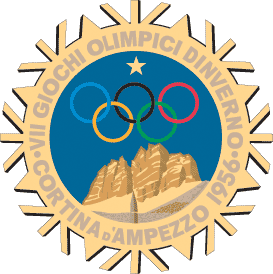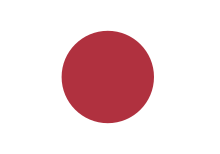
The 1952 Winter Olympics, officially known as the VI Olympic Winter Games and commonly known as Oslo 1952, was a winter multi-sport event held from 14 to 25 February 1952 in Oslo, the capital of Norway.

The 1960 Winter Olympics were a winter multi-sport event held from February 18 to 28, 1960, at the Squaw Valley Resort in Squaw Valley, California, United States. The resort was chosen to host the Games at the 1956 meeting of the International Olympic Committee (IOC). Squaw Valley was an undeveloped resort in 1955, so the infrastructure and all of the venues were built between 1956 and 1960 at a cost of US$80,000,000. The layout was designed to be intimate, allowing spectators and competitors to reach most of the venues on foot.

The 1956 Winter Olympics, officially known as the VII Olympic Winter Games and commonly known as Cortina d'Ampezzo 1956, was a multi-sport event held in Cortina d'Ampezzo, Italy, from 26 January to 5 February 1956.

The 1964 Winter Olympics, officially known as the IX Olympic Winter Games and commonly known as Innsbruck 1964, was a winter multi-sport event which was celebrated in Innsbruck, Austria, from January 29 to February 9, 1964. The city was already an Olympic candidate, unsuccessfully bidding to host the 1960 Games. Innsbruck won the 1964 Games bid, defeating the cities of Calgary in Canada and Lahti in Finland. The sports venues, many of which were built for the Games, were located within a radius of 20 km (12 mi) around Innsbruck. The Games included 1,091 athletes from 36 nations, which was a record for the Winter Games at the time. Athletes participated in six sports and ten disciplines which bring together a total of thirty-four official events, seven more than the 1960 Winter Olympic Games. The luge made its debut on the Olympic program. Three Asian nations made their Winter Games debut: North Korea, India and Mongolia.
The 1972 Winter Olympics, officially the XI Olympic Winter Games and commonly known as Sapporo 1972, were a winter multi-sport event held from February 3 to 13, 1972, in Sapporo, Hokkaido Prefecture, Japan. It was the first Winter Olympic Games to take place outside Europe and North America.
Alpine skiing at the 1968 Winter Olympics consisted of six events, held 9–17 February at Chamrousse, southeast of Grenoble, France. Jean-Claude Killy of France won all three men's events, repeating Toni Sailer's triple-gold of 1956. Since Killy's feat, no male alpine ski racer has won three gold medals in a single Olympics..

Alpine skiing at the 1964 Winter Olympics consisted of six events, held near Innsbruck, Austria, from January 30 to February 8, 1964.

Australia sent a delegation to compete at the 1956 Winter Olympics from the 26 January to 5 February 1956 in Cortina d'Ampezzo, Italy. This was the nation's third appearance at the Winter Olympic Games with their last appearance being in 1952.

Alpine skiing at the 1972 Winter Olympics consisted of six events, held February 5–13 near Sapporo, Japan. The downhills were held at Mount Eniwa, and the four technical events at Teine.
At the 1956 Winter Olympics in Cortina d'Ampezzo, Italy, the six alpine skiing events were held from Friday, 27 January to Friday, 3 February.

Alpine skiing has been contested at every Winter Olympics since 1936, when a combined event was held in Garmisch-Partenkirchen, Germany.

Norway competed at the 1928 Winter Olympics in St. Moritz, Switzerland. Norway ranked first in the total medal count, as they had in the inaugural 1924 Games.

Italy was the host nation for the 1956 Winter Olympics in Cortina d'Ampezzo. It was the first time that Italy had hosted the Olympic Games.

Finland competed at the 1956 Winter Olympics in Cortina d'Ampezzo, Italy.

Poland competed at the 1956 Winter Olympics in Cortina d'Ampezzo, Italy. Franciszek Gąsienica Groń won Poland's first ever medal at the Winter Olympic Games.

Bolivia sent a delegation to compete in the Winter Olympic Games for the first time at the 1956 Winter Olympics in Cortina d'Ampezzo, Italy from 26 January to 5 February 1956. The only competitor in the delegation was alpine skier René Farwig. In the men's giant slalom he came in 75th place, and he was disqualified from the men's slalom. It would be 24 years before Bolivia returned to the Winter Olympics, at the 1980 Winter Olympics.

Lebanon sent a delegation to compete at the 2010 Winter Olympics in Vancouver, British Columbia, Canada from 12–28 February 2010. This was Lebanon's 15th appearance at a Winter Olympic Games. The Lebanese team consisted of three alpine skiers. Lebanon has never won a medal at a Winter Olympics, and their best performance in Vancouver was 37th in the women's super-G by Chirine Njeim; Ghassan Achi failed to post a result in either of his races, and Jacky Chamoun finished 54th in her only race.
For the 1956 Winter Olympics in Cortina d'Ampezzo, Italy, a total of eight sports venues were used. All of the venues used were new or rebuilt. To make use of television coverage for the first time in the Winter Olympics, the cross-country skiing stadium was constructed to allow the best coverage. Five of the venues used for these games would appear in the James Bond film For Your Eyes Only twenty-five years later.

For the 1980 Winter Olympics in Lake Placid, New York, United States, a total of seven sports venues were used. All five of the venues used for the 1932 Winter Olympics were also used at the 1980 Winter Games with adjustments. These adjustments included electronic scoreboards, increased refrigeration, and the addition of a separate luge track. This was the last Winter Olympics where there were separate bobsleigh and luge tracks. The closest finish in Olympic history in cross-country skiing led skiing officials to time future events in hundredths of a second rather than tenths of a second. This would also apply to biathlon events. Eric Heiden won five gold medals at the speed skating oval while the "Miracle on Ice" took place between Americans and Soviets at the Olympic Center. In the late 1990s, the luge track was demolished and a new combination track was constructed in time for the only Winter Goodwill Games held. The sliding venue was named to the American National Register of Historical Places in February 2010.















